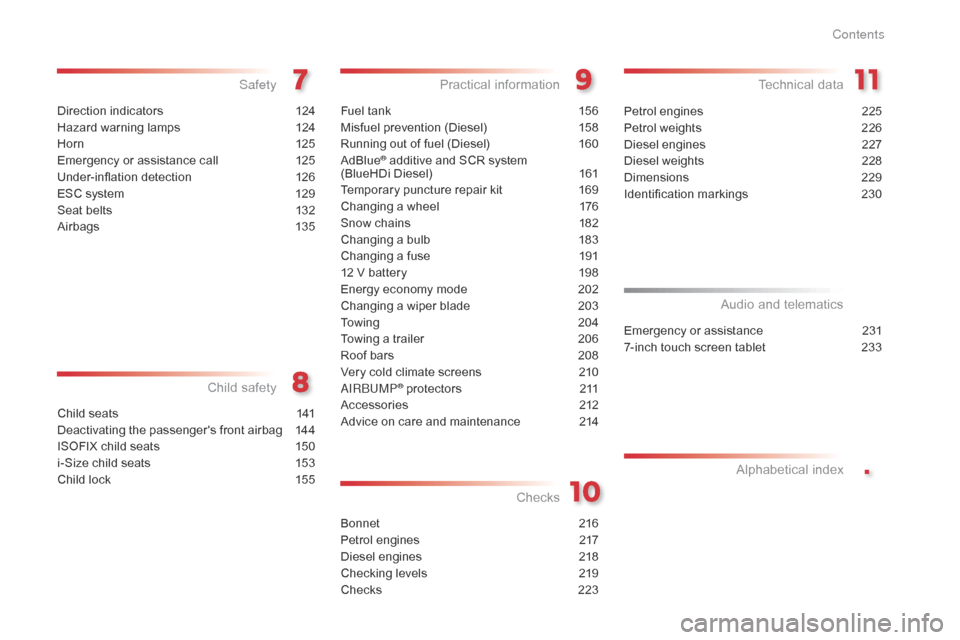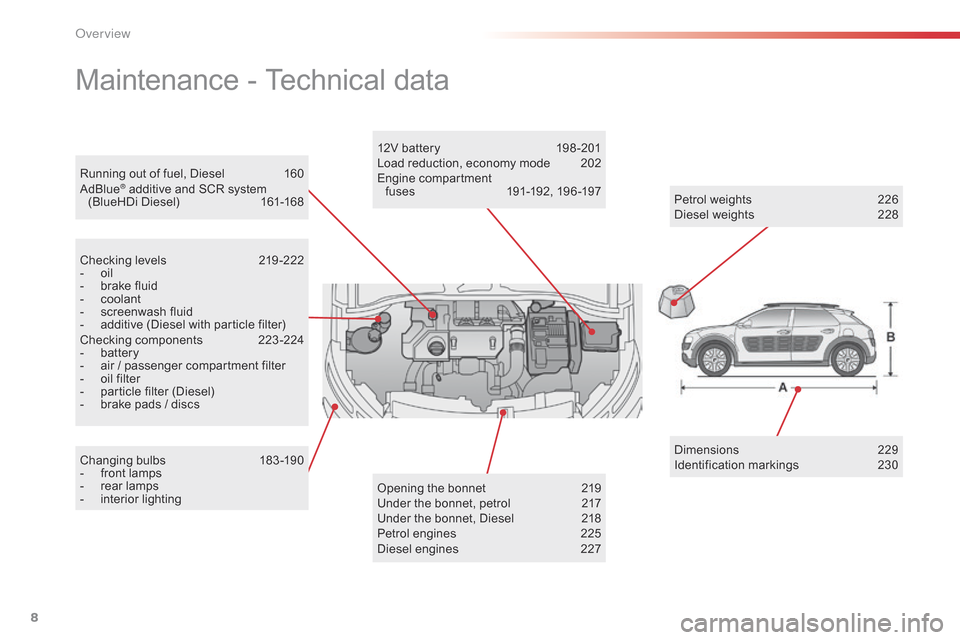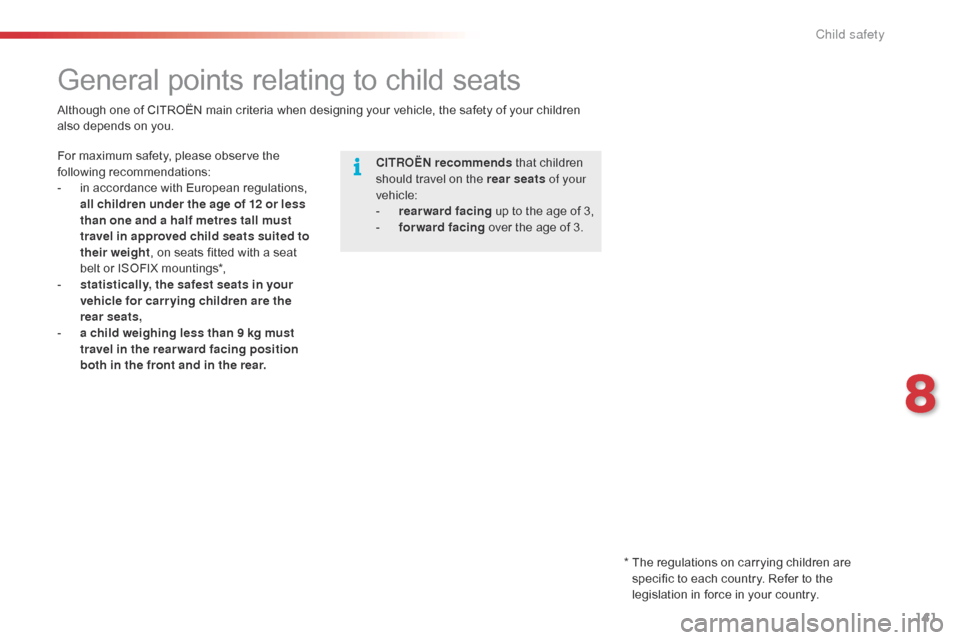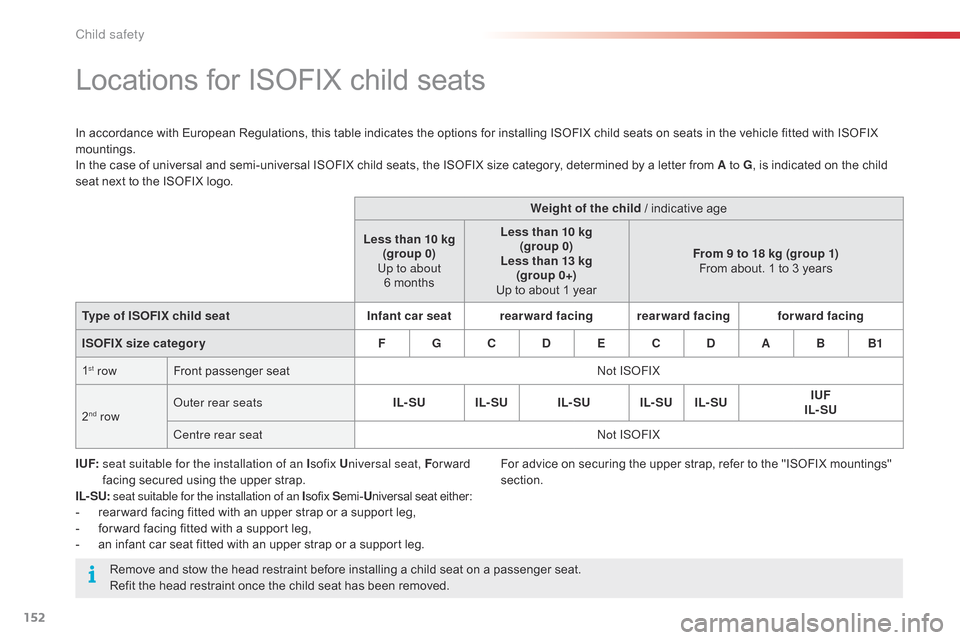weight Citroen C4 CACTUS RHD 2015 1.G Owner's Manual
[x] Cancel search | Manufacturer: CITROEN, Model Year: 2015, Model line: C4 CACTUS RHD, Model: Citroen C4 CACTUS RHD 2015 1.GPages: 326, PDF Size: 8.56 MB
Page 5 of 326

.
Direction indicators 124
Hazard warning lamps
1
24
H or n
12
5
Emergency
or assistance call
1
25
Under-inflation
d
etection
1
26
ESC
system
1
29
Seat
belts
1
32
Airbags
1
35
Safety
Child seats 1 41
Deactivating the passenger's front airbag
1
44
ISOFIX
child seats
1
50
i-Size
child seats
1
53
Child
lock
1
55
Child safety
Checks
Fuel tank 156
Misfuel prevention (Diesel)
1
58
Running
out of fuel (Diesel)
1
60
AdBlue
® additive and SCR system
(
BlueHDi Diesel) 1 61
Temporary
puncture repair kit
1
69
Changing
a wheel
1
76
Snow
chains
1
82
Changing
a bulb
1
83
Changing
a fuse
1
91
12
V
battery
1
98
Energy
economy mode
2
02
Changing
a wiper blade
2
03
To w i n g
2
0 4
Towing
a trailer
2
06
Roof
bars
2
08
Very
cold climate screens
2
10
aI
R
b
UM
P
® protectors 2 11
Accessories
2
12
Advice
on
care and maintenance
2
14
Practical information Technical da ta
Emergency or assistance 231
7-inch touch screen tablet
2
33
Audio and telematics
Alphabetical
in
dex
Bonnet 2 16
Petrol engines
2
17
Diesel
engines
2
18
Checking
levels
2
19
Checks
2
23Petrol
engines
2
25
Petrol weights
2
26
Diesel engines
2
27
Diesel weights
2
28
Dimensions
2
29
Identification
ma
rkings
2
30
Contents
Page 10 of 326

8
Running out of fuel, Diesel 160
AdBlue® additive and SCR system (
BlueHDi Diesel) 1 61-168
Maintenance - Technical data
Checking levels 2 19 -222
- o il
-
b
rake fluid
-
c
oolant
-
s
creenwash fluid
-
a
dditive (Diesel with particle filter)
Checking
c
omponents
2
23-224
-
b
attery
-
a
ir / passenger compartment filter
-
o
il filter
-
p
article filter (Diesel)
-
b
rake pads / discs
Changing
bu
lbs
1
83-190
-
f
ront lamps
-
r
ear lamps
-
i
nterior
l
ighting Dimensions
2
29
Identification
ma
rkings
2
30
Petrol
weights
2
26
Diesel weights
2
28
Opening the bonnet
2
19
Under
the bonnet, petrol
2
17
Under
the bonnet, Diesel
2
18
Petrol
engines
2
25
Diesel
engines
2
27
12V
battery
1
98 -201
Load reduction, economy mode
2
02
Engine
c
ompartment
f
uses
19
1-192,
19
6 -197
over view
Page 143 of 326

141
General points relating to child seats
CITROËN recommends that children s
hould travel on the rear seats of your
vehicle:
-
r
earward facing
up to the age of 3,
-
fo
rward facing
over the age of 3.
Although
one
of
CITROËN
main
criteria
when
designing
your vehicle, the safety of your children
a
lso
depends
on
you.
For
maximum
safety,
please
observe
the
f
ollowing r
ecommendations:
-
i
n
accordance
with
European
regulations,
a
ll children under the age of 12 or less
than one and a half metres tall must
travel in approved child seats suited to
their weight ,
on
seats
fitted
with
a
seat
b
elt
or
ISOFIX
mountings*,
-
s
tatistically, the safest seats in your
vehicle for carr ying children are the
rear seats,
-
a c
hild weighing less than 9 kg must
travel in the rear ward facing position
both in the front and in the rear.
*
T
he regulations on carrying children are
s
pecific to each country. Refer to the
l
egislation in force in your country.
8
Child safety
Page 150 of 326

148
Installation of child seats secured using the seat belt
In accordance with European regulations, this table indicates the options for installing child seats secured using the seat belt and universally approved ( a)
in relation to the weight of the child and the seat in the vehicle.
Seat Weight of the child /
indicative age
Groups 0 (b) and 0+ Bir th to 13 kg
Up
to about 1 yearGroup 1
From 9 to 18 kg
From
1 to about 3 yearsGroup 2
From 15 to 25 kg
From
3 to about 6 yearsGroup 3
From 22 to 36 kg
From 6 to about 10 years
1st row Front passenger seat (
c ) without h
eight adjustment (d ) U
UUU
2
nd row Outer rear seats (
e ) UUUU
Centre rear seat (e ) U (f) U (f) U U
Child safety
Page 154 of 326

152
Locations for ISOFIX child seats
In accordance with European Regulations, this table indicates the options for installing ISOFIX child seats on seats in the vehicle fitted with ISOFIX mountings.
In
the case of universal and semi-universal ISOFIX child seats, the ISOFIX size category, determined by a letter from A to G,
is indicated on the child
s
eat next to the ISOFIX logo.
I UF:
s
eat suitable for the installation of an I sofix
Universal seat, F or ward
f
acing secured using the upper strap.
IL- SU: seat suitable for the installation of an I sofix
Semi- Universal
sea
t
ei
ther:
-
r
ear ward facing fitted with an upper strap or a support leg,
-
f
or ward facing fitted with a support leg,
-
a
n infant car seat fitted with an upper strap or a support leg.Weight of the child
/ indicative age
Less than 10 kg (group 0)
Up to about 6 months Less than 10 kg
(group 0)
Less than 13 kg (group 0+)
Up
to about 1 yearFrom 9 to 18 kg (group 1)
From
about. 1 to 3 years
Type of ISOFIX child seat Infant car seatrearward facing rearward facing forward facing
ISOFIX size categor y F G C D E C D A B B1
1
st row Front p assenger sea tn ot ISo FIX
2
nd rowou ter rear seats
IL- SU IL- SU IL- SU IL- SU IL- SU IUF
IL- SU
Centre rear seat
n
ot IS
o
FIX
Remove
and stow the head restraint before installing a child seat on a passenger seat.
Refit
the head restraint once the child seat has been removed.For
advice on securing the upper strap, refer to the "ISOFIX mountings"
s
ection.
Child safety
Page 206 of 326

204
To w i n g
General recommendations
Observe the legislation in force in your country.
E nsure that the weight of the towing vehicle is higher than that of the towed vehicle.
The
driver must remain at the wheel of the towed vehicle and must have a valid driving licence.
When
towing a vehicle with all four wheels on the ground, always use an approved towing arm;
r
ope and straps are prohibited.
The
towing vehicle must move off gently.
When
towing a vehicle with the engine off, there is no longer any power assistance for braking
o
r steering.
In
the following cases, you must always call on a professional recovery service:
-
v
ehicle broken down on a motor way or fast road,
-
f
our-wheel drive vehicle,
-
w
hen it is not possible to put the gearbox into neutral, unlock the steering, or release the
par
king
b
rake,
-
t
owing with only two wheels on the ground,
-
w
here there is no approved towing arm available...
Procedure
for
having
your
vehicle
towed
or
for
towing
another vehicle using a removable towing eye.
The towing eye
is
stowed
under
the
boot
floor,
o
r
may
be
located
under
the
front
passenger
sea
t, d
epending o
n v
ersion.
Practical information
Page 209 of 326

207
Driving advice
Distribution of loads
F Distribute the load in the trailer so that t
he heaviest items are as close as
p
ossible to the axle and the nose weight
a
pproaches the maximum permitted
w
ithout exceeding it.
Air
density decreases with altitude, thus
r
educing engine per formance. Above
1 0
00 metres, the maximum towed load must
b
e reduced by 10 % for every 1 000 metres of
al
titude.
Side wind
F Take into account the increased sensitivity t
o side wind.
Cooling
Towing a trailer on a slope increases the temperature of the coolant.
As
the fan is electrically controlled, its cooling
c
apacity is not dependent on the engine speed.
F
T
o lower the engine speed, reduce your
s
peed.
The
maximum towed load on a long incline
d
epends on the gradient and the ambient
t
emperature.
In
all cases, keep a check on the coolant
t
emperature. F
I
f the warning lamp and the
S
TOP
warning lamp come on,
s
top the vehicle and switch off
t
he engine as soon as possible.
Braking
Towing a trailer increases the braking distance.
T o avoid overheating of the brakes on a long
m
ountain type of descent, the use of engine
b
raking is recommended.
Ty r e s
F Check the tyre pressures of the towing v
ehicle and of the trailer, observing the
re
commended
p
ressures.
Lighting
F Check the electrical lighting and signalling o
n the trailer.
Refer
to
the
"Technical
data"
section
for
details
o
f
the
weights
and
towed
loads
which
apply
to
y
our
vehicle.
When
not
towing
a
trailer,
remove
the
q
uickly-detachable
tow
ball
before
d
riving. The
rear parking sensors will be
d
eactivated automatically if a genuine
C
ITROËN towbar is used.
9
Practical information
Page 228 of 326

226
EnginePureTech 75PureTech 82 PureTech 82 S&SPureTech 110 S&S
Gearbox Manual
(5-speed) Manual
(5-speed) ETG
e
lectronic
(5-speed) Manual
(5-speed)
Model code 0PHMU0PHMZ0PHNZ
-
U
nladen weight 965965 9751
020
-
K
erb weight* 1
0401
0401
0501
095
-
G
ross vehicle weight (GV W) 1
5001
5001
5101
555
-
G
ross train weight (GTW)
o
n a 12 % gradient 1
9001
9001
9102
155
-
B
raked trailer**
o
n a 10 % or 12 % gradient 720
720 725825
-
U
nbraked trailer** 520520 525545
-
R
ecommended nose weight (towbar)55555555
Weights and towed loads (in kg) - PETROL
The GTW and towed load values indicated are valid up to a maximum altitude of 1 000 metres; the towed load mentioned must be reduced by 10 % for e
ach additional 1 000 metres of altitude.
Never
exceed 60 mph (100 km/h) when towing (comply with the legislation in force in your country).
High
ambient temperatures may result in a reduction in the per formance of the vehicle to protect the engine; if the ambient temperature is above 37 °C,
l
imit the towed load.
*
The kerb weight is equal to the unladen weight + driver (75 kg).
**
Maximum trailer weight within the GTW limit.
Technical data
Page 230 of 326

228
Enginee-HDi 92BlueHDi 100
Gearbox ETG
e
lectronic
(6-speed) Manual
(5-speed)
Model code 0B9HP0BBHY
-
U
nladen weight 1
0551
070
-
K
erb weight* 1
1301
145
-
G
ross vehicle weight (GV W) 1
6051
610
-
G
ross train weight (GTW)
o
n a 12% gradient 2
2052
210
-
B
raked trailer (within GTW limit)
o
n a 10% or 12% gradient 825
825
-
U
nbraked trailer 565570
-
R
ecommended nose weight (towbar) 55 55
Weights and towed loads (in kg) - DIESEL
* The kerb weight is equal to the unladen weight + driver (75 kg).
T he GTW and towed load values indicated are valid up to a maximum altitude of 1 000 metres; the towed load mentioned must be reduced by 10 % for
e
ach additional 1 000 metres of altitude.
Never exceed 60 mph (100 km/h) when towing (comply with the legislation in force in your country).
High ambient temperatures may result in a reduction in the per formance of the vehicle to protect the engine; if the ambient temperature is above 37 °C,
l
imit the towed load.
Technical data
Page 232 of 326

230
Identification markingsVarious visible markings for the identification of your vehicle.
A.
V
ehicle Identification Number (VIN)
under the bonnet.
T
his number is engraved on the chassis
n
ear the right hand front wheel arch. The
tyre pressures must be checked
w
hen the tyres are cold, at least once
a
month.
If the tyre pressures are too low, this
increases
fuel consumption.
C.
M
anufacturer's label.
T
his self-destroying label on the middle
d
oor pillar, right or left hand side, contains
th
e
f
ollowing
i
nformation:
-
t
he manufacturer's name,
-
t
he European whole vehicle type
a
pproval number,
-
t
he vehicle identification number (VIN),
-
t
he maximum authorised weight (gross
ve
hicle
w
eight),
-
t
he maximum authorised weight with
t
railer (gross train weight),
-
t
he maximum front axle weight,
-
t
he maximum rear axle weight.D.
T
yre/paint label.
T
his label on the middle door pillar, driver's
s
ide, contains the following information:
-
t
he tyre inflation pressures, laden and
u
nladen,
-
t
he tyre sizes (including the tyre load
i
ndex and speed rating),
-
t
he inflation pressure for the spare
w
heel,
-
t
he paint colour code.
B.
V
ehicle Identification Number (VIN) on
the windscreen lower cross member.
T
his number is indicated on a self-
adhesive
label which is visible through
t
he windscreen.
Technical data